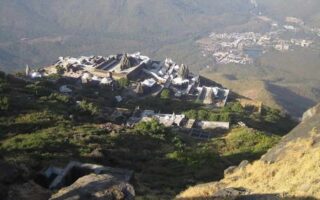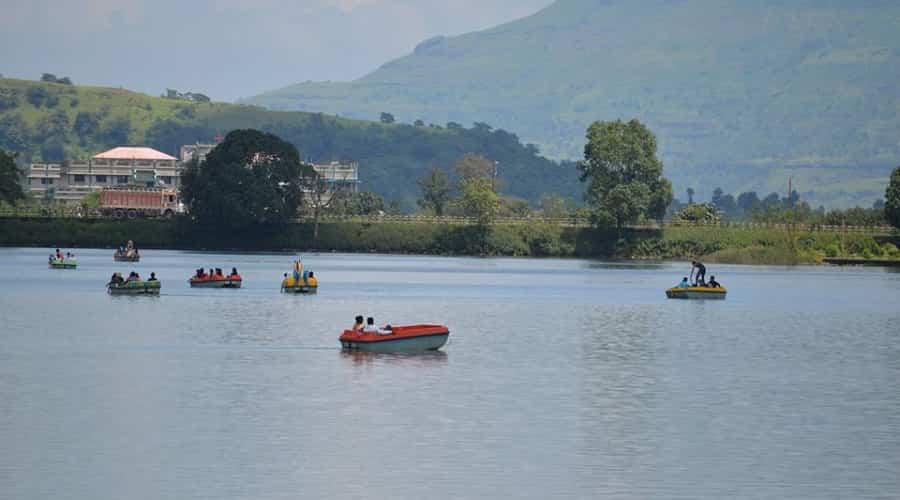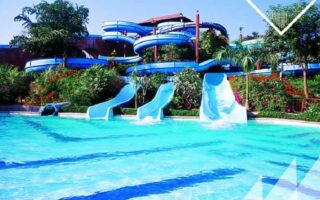Gujarat, a state in western India boasts of its rich historical background. Several glorious historical relics such as forts, monuments and Havelis are scattered all across the state, enticing a history buff like anything. Exploring these historical places in Gujarat allows you to have a sneak peek into our golden past and makes you feel proud of our rich cultural heritage. Time stands arrested in these historical places. Visiting these places is indeed an experience in itself. You may come to feel adventurous and may even experience goose bumps, thinking that the place where you are standing had received the stomps of a celebrated King or Queen in the yesteryears. The top historical places & monuments in Gujarat that any Gujarat Travel Package would invariably include are-
Laxmi Vilas Palace, Baroda
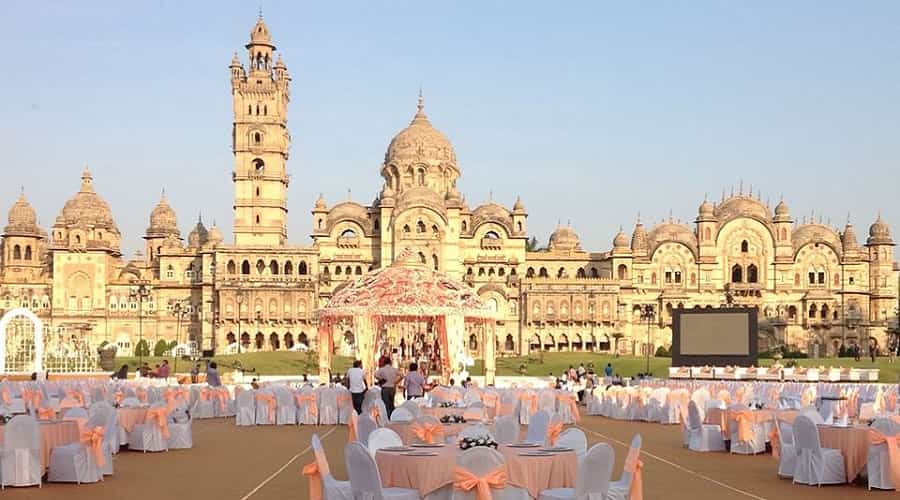
The Laxmi Vilas Palace of Baroda reflects the architectural excellence of the Indo-Saracenic architecture style. The construction of this palatial building was done by the famed Maharaja Sayaji Rao II in the year 1890. The construction was done in a lavish way and incurred an expenditure of over Rs 60 Lakhs during that time. The beauty of the palace’s Darbar hall attracts many. Many musical concerts, cultural events etc has the Darbar hall as their venue. The hall is offered on rent for these purposes. The palace remains open for visitors between 11.00 am and 5.00pm each day of the week except Monday.
- Built by: Maharaja Sayajirao Gaekwad III
- Year: 1890
- Location: Laxmi Vilas Palace, Moti Baug Vadodara , Gujarat
- Visit Duration: 2 to 3 hours
- Entry Fee:
- For Indian – ₹-225/-
- Foreign Tourists – ₹-400/-
- Timings: All days of the week except Mon 11:00 AM – 5:30 PM
- Best time to Visit: October to December
- How to Reach:
- By Road: One can conveniently get in Vadodara by road as it is well connected to National Highway-8 which connects all the major cities of India.
- By Airport: Vadodara has its own airport named as Civil Airport Harni, which is well connected to Mumbai, Hyderabad and Bangalore etc.
- By Bus: One can easily reach Vadodara by bus too as it has a good bus service called as Intercity bus service towards this place.
- By Train: One can easily get in Vadodara by rail as it is most busiest railway junction of Gujarat where all trains from Ahmedabad, Mumbai, Delhi and Kota etc.
Also Read: Popular Places to Visit in Gujarat
Rani ki Vav, Patan
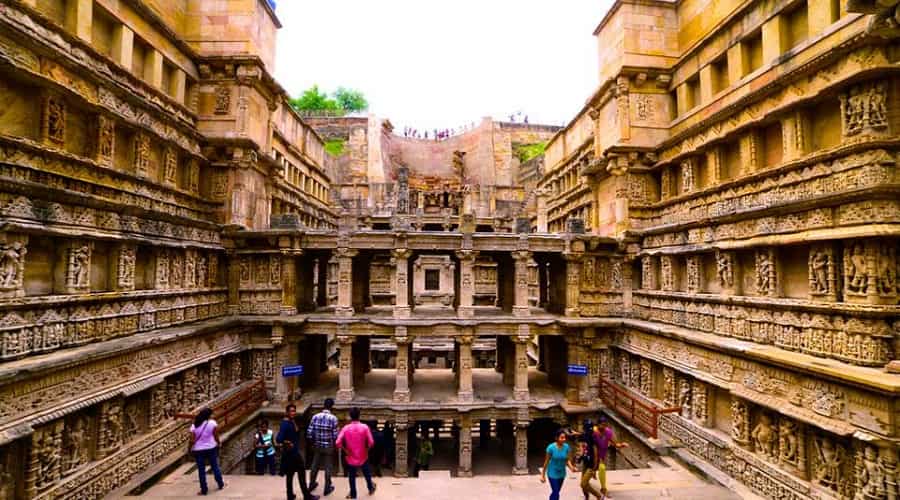
Rani ki Vav is the famous step well that tourists from far and wide come to visit. This ornate well is indeed an architectural masterpiece. Queen Udayamati took the initiative of constructing this incredible step well in remembrance of King Bhimdev I. Though the actual year of construction of this well was 1063, several other minor constructions took place after that. This well was then filled up with waters drawn from the famed Saraswati River. Today it is an important tourist spot transporting you back to those kingly eras.
- Built by: Rani Udaymati
- Year: 11th century AD
- Location: Mohan Nagar Society, Patan, Gujarat 384265
- Visit Duration: 1 to 2 hours
- Entry Fee:
- For Indian – ₹-15/-
- Foreign Tourists – ₹-200/-
- Timings: 08:00 AM – 06:00 PM
- Best time to Visit: October to March
- How to Reach: Nearest airport- Ahmedabad airport (123 km), nearest railway station- Mehsana Junction (52 km).
Also Read: Places to Visit in Patan
Vijay Vilas Palace, Mandvi
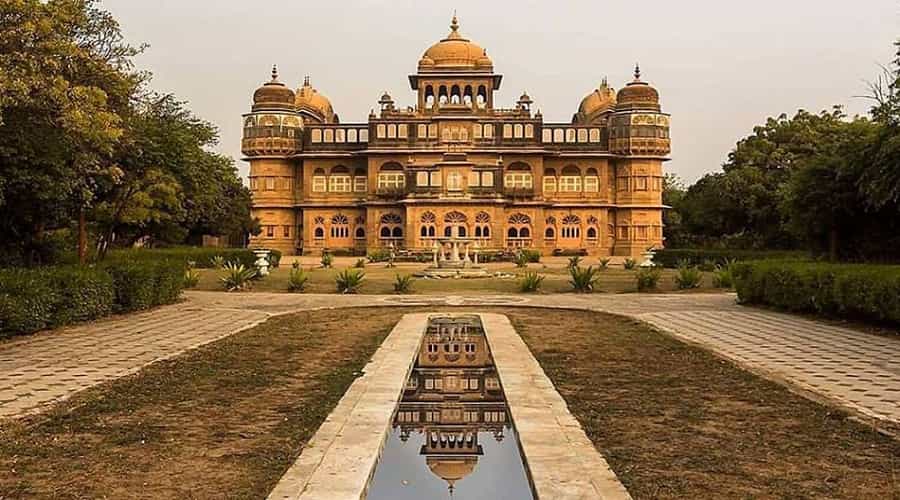
The Vijay Vilas palace is a lavish palatial construction making town Mandvi of Kutch region famous enough. This ornate palace was constructed around 1929 under the initiative of Prince of Kutch. Today this wonderful palace is thickly flocked by tourists. Also, many movie directors choose the palace as their shooting venue.
- Built by: Maharao Shri Khengarji III
- Year: 1920-1929
- Location: Vijay Vilas Palace Road, District Kutch, Mandvi Rural, Gujarat 370465
- Visit Duration: 1 to 2 hours
- Entry Fee: ₹-50/-, Video Camera: ₹-200/-
- Timings: 09:00 AM – 06:00 PM
- Best time to Visit: October to March
- How to Reach: Nearest airport- Bhuj airport (60 km), nearest railway station- Gandhidham Railway Station (112 km).
Modhera Sun
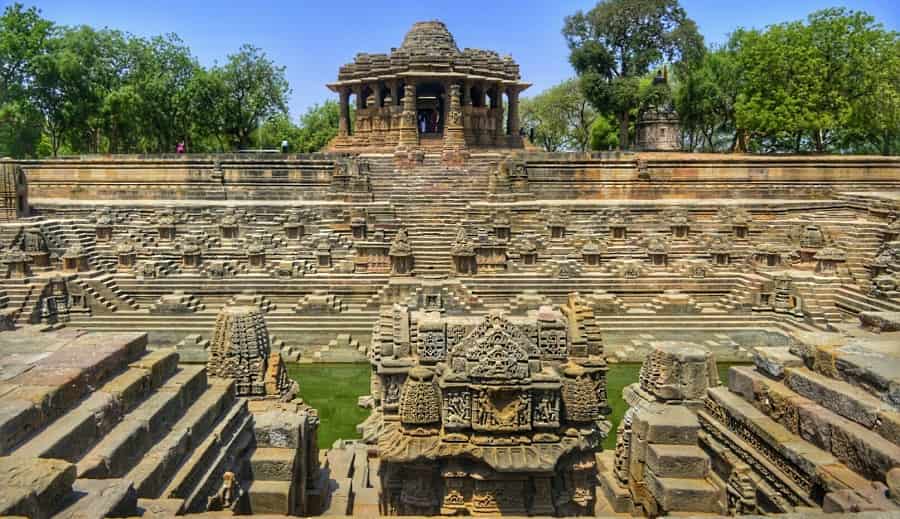
A legend based on the great Epic Ramayana goes with the information that one Brahmin of Modh community performed religious rites according to Vedic prescriptions to ward of the sin cast upon Lord Ram for killing Ravana and the place in which these rites were performed is called Modhera, Jain manuscripts calling this area as Bhagvad Gram, however, Modhera is more known for the Modhera Sun temple raised by Solanki community as per historical references.
While there is a temple for Modheshwari the mother of the Brahmin who conducted those religious rites for recovering Lord Ram from Brahmahathi dosha, what is more famous is the Modhera Sun temple in Gujarat which is built by King Bhimdev of Solanki dynasty in 1026 AD where the principal deity is Sun God, for whom there are temples in different parts of the country, and people go to these temples to offer their prayers to Sun God to please Him for remedies suggested by Astrological beliefs.
- Built by: Bhima I
- Year: 1026 CE
- Location: Mehsana – Becharaji Rd, Highway, Modhera
- Timings: 7:00AM to 6:00PM
- Entry fee: Rs.25/- for Indian, Rs.300/- Rs for foreigners
- Time required: 30 minutes to 1 hour
- Best time to visit: October – March
- How to Reach: Nearest railway station- Mahesana JN. (27 km), nearest airport- Sardar Vallabhbhai Patel International Airport, Ahmedabad (76 Km).
Dholavira, Kutch
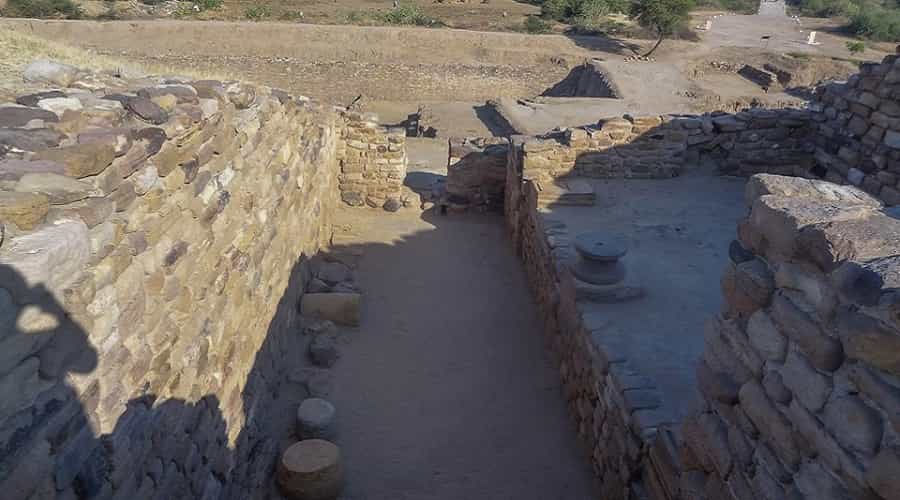
Dholavira in Gujarat’s Kutch region is a world famous excavation site offering glimpse of the famed Harappan or Indus Valley Civilization; a 4500 years old civilization that would take one aback at the mastery of urban planning plus sophisticated architecture even so many years back. This site was discovered during an archaeological excavation undertaken by well known archaeologist JP Joshi around the year 1967.
- Time Period: 3000-1500 BCE
- Location: Khadirbet, Kutch district, Gujarat
- Area: 47 ha
- Entry Fee: No entry fee
- Timings: 06:00 AM – 08:00 PM
- Best time to Visit: October to March
- How to Reach: Nearest airport- Bhuj airport (220 km), nearest railway station- Samakhiali Railway Station (137 km).
Sidi Saiyyed Mosque, Ahmedabad
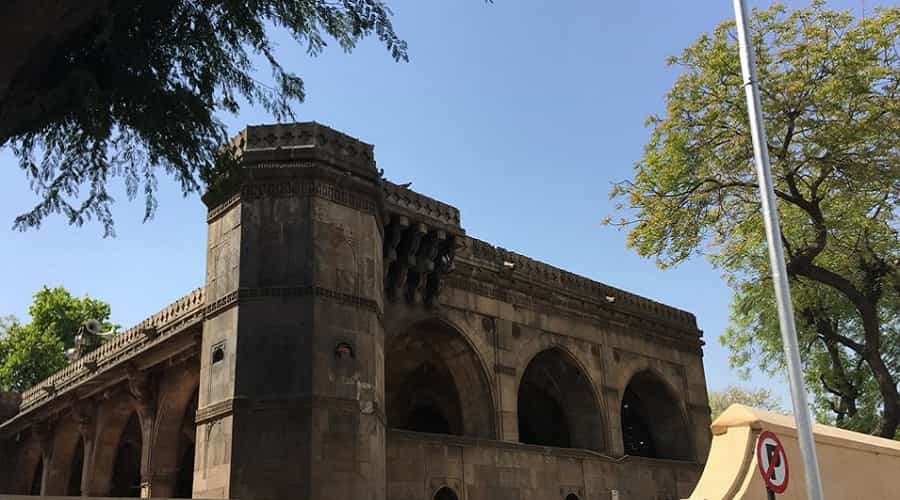
Sidi Saiyyed mosque was constructed by Sidi Saiyyed, the follower of the famous Sultan Ahmad Shah around the year 1573. Mind-blowing Indo-Saracenic architecture comes alive through this mosque; a glorious relic of the Sultanate period. The intricate Jali work, ornate stone carvings and beautiful carvings done out of marble make the Sidi Saiyyed Mosque one of a kind.
- Built by: Sidi Saiyyid
- Year: 1572–73 AD
- Location: Bhadra Rd, Old City, Gheekanta, Lal Darwaja, Ahmedabad
- Visit Duration: Approx 1 Hour
- Entry Fee: No entry fee
- Timings: 07:00 am – 06:00 pm
- Best time to Visit: September to February
- How to Reach: Nearest airport- Sardar Vallabbhai Patel Airport, nearest railway station- Ahmedabad junction.
Bhujiyo Kotho, Jamnagar
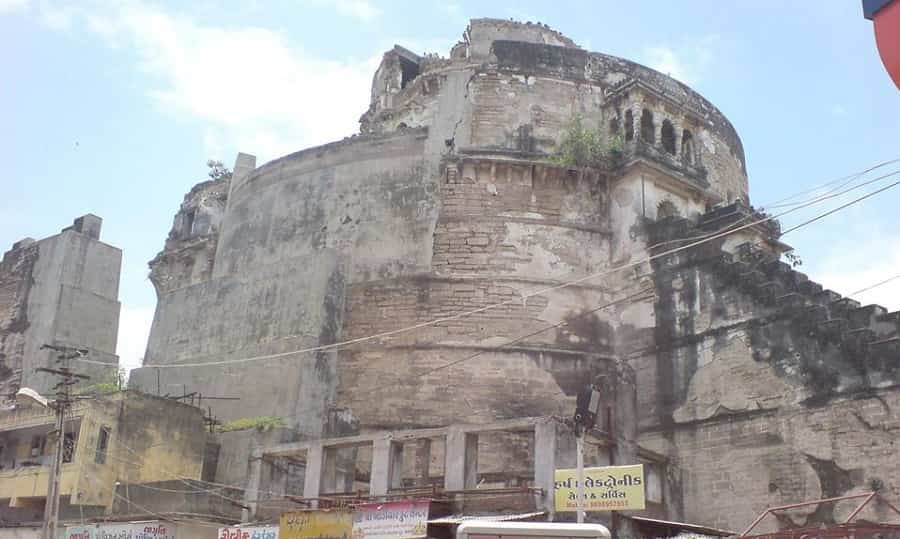
Bhujiyo Kotho in Jamnagar is an important historic building set up by the rulers of the yesteryears. The building had been an army bastion where soldiers resided and kept a watch on the entire city with an intention to protect the city against foreign invaders. The Kotho has a massive height and that is what allows one to catch a glimpse of entire Jamnagar; the then Nawanagar. The Kotho stands just at the entrance of the city.
- Built by: Jam Rava Jadeja
- Year: 1540 AD
- Location: Shankar Tekri, Jamnagar Gujarat 361005
- Entry Fee: No entry fee
- Timings: 10:00 am – 05:00 pm
- Best time to Visit: November to February
- How to Reach: Nearest airport- Jamnagar airport (9 km), nearest railway station- Jamnagar railway station (15 km).
Lakhota Fort, Jamnagar
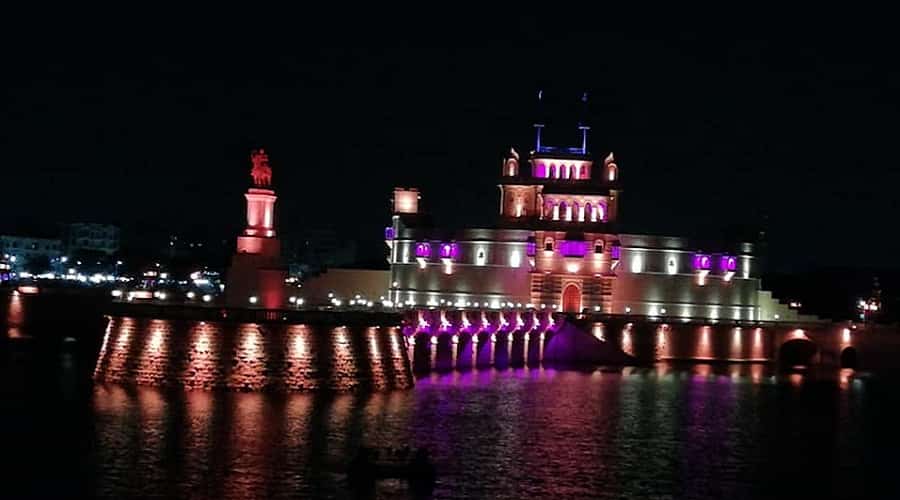
The historic Lakhota fort stands amid the Lakhota Lake which acts as a kind of moat around the fort. This fort was set up under the initiative of Jam Ranmalji. Initially this fort was used as an army den where soldiers used to put up in an attempt to keep away attackers. Later it was used for the purpose of drought relief. Today the fort houses a museum exhibiting things like pottery, swords, muskets, whale’s skeleton etc dating back to a time period ranging between 9th and 18th century.
- Built by: King Jam Ranmal
- Year: 18th century
- Location: Government Colony, Jamnagar, Gujarat 361005
- Visit Duration: 1 hour
- Entry Fee:
- For Indian – ₹-10/-
- Foreign Tourists – ₹-50/-
- Timings: 09:00 am – 08:00 pm
- Best time to Visit: October to March
- How to Reach: Nearest airport- Jamnagar airport (9 km), nearest railway station- Jamnagar Old Railway Station (4 km).
Aina Mahal, Bhuj
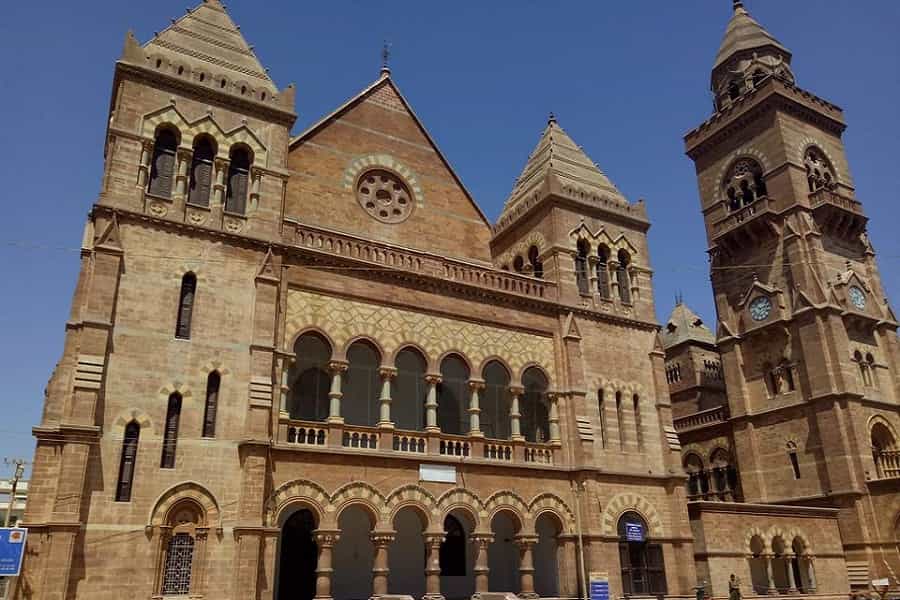
The splendid Aina Mahal was set up around the 18th century by the famed Rao Lakhpatji. The year of construction of this beautiful Mahal is 1761. Luxurious, royal thoughts inspired the embellishments, layout and design of the Mahal. Adept craftsman, Ramsinh Malam perfected those royal thoughts giving those a beautiful shape in the form of the Aina Mahal. The architectural style of this Mahal is an Indo European one and shows beautiful embellishments with the help of glass pieces. Today Aina Mahal is a celebrated museum exhibiting some great collectibles and paintings.
- Built by: Maharao Lakhpatji
- Year: 1750 AD
- Location: Maharav Of Kutch, Darbargadh Chowk, Bhuj
- Visit Duration: Approx 2 hours
- Entry Fee:
- For Indian – ₹-20/-
- Foreign Tourists – ₹-50/-
- Timings: 09:00 am – 06:00 pm
- Best time to Visit: October to March
- How to Reach: Nearest airport- Bhuj airport (4 km from Bhuj city), nearest railway station- Bhuj railway station (2 km).
Uparkot Fort, Junagadh
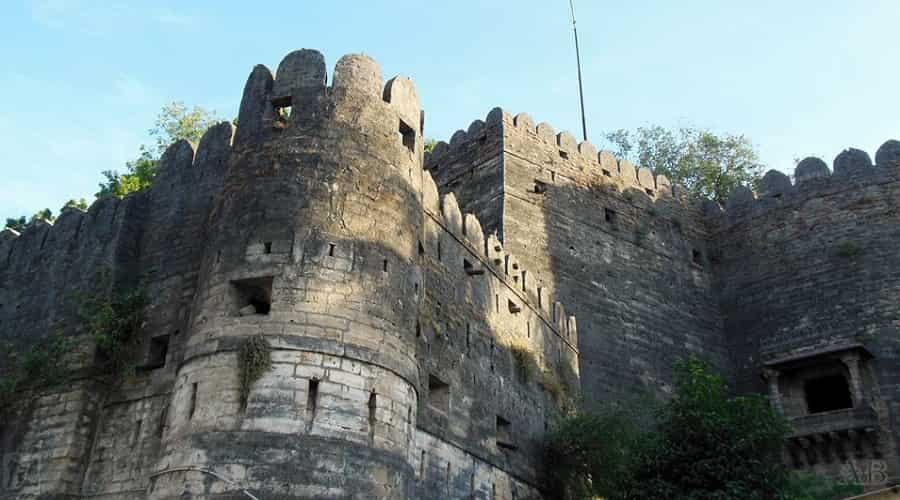
The Uparkot Fort of Junagadh was believed to have been set up by the legendary Chandragupta Maurya around 319 BC. According to history the fort has been besieged as many as 16 times and one of the sieges went on for 12 long years. Buddhist caves, step wells etc mark the architecture of this ancient fort.
- Built by: Chandragupta Maurya
- Year: 320 BC
- Location: Mullawada, Junagadh, Gujarat 362001
- Visit Duration: 1 to 2 hours
- Entry Fee:
- For Indian – ₹-25/-
- Foreign Tourists – ₹-300/-
- Timings: 06:00 AM to 06:00 PM
- Best time to Visit: November to February
- How to Reach: Nearest airport- Rajkot airport (103 km), nearest railway station- Junagadh Junction railway station (2 km).
The Vadnagar Toran, Vadnagar
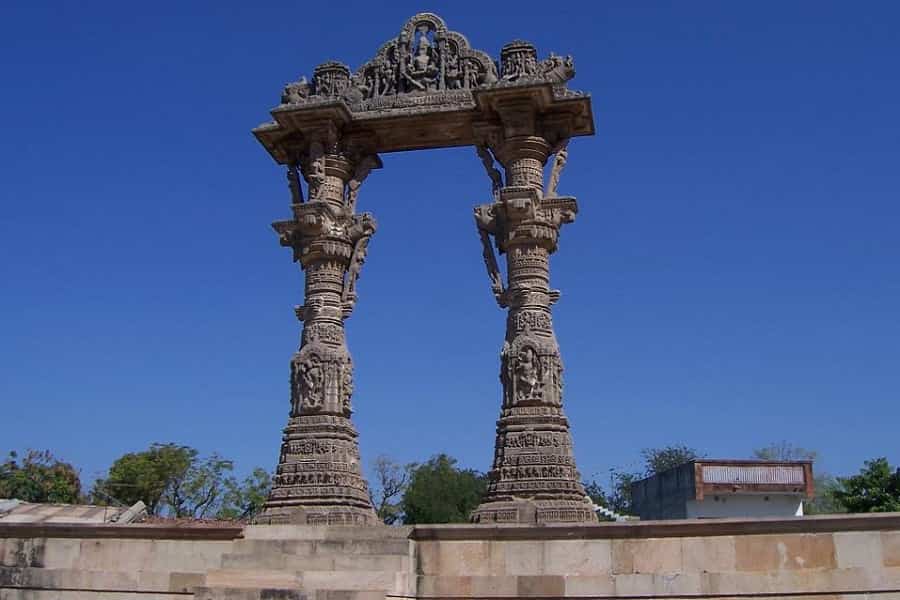
The Toran of Vadnagar is made out of yellow and red sandstones and is a 12th century architectural masterpiece. It consists in two columns topped by an ornate arch. The Torans depict images denoting victory or hunting expeditions. This famous Toran stands along Lake Sharmistha’s banks and is a typical example of a royal entrance door.
- Built by: Solanki ruler
- Year: 12th century
- Location: Near Arjun Bari Gate, Vadnagar
- Visit Duration: Approx 1 hour
- Entry Fee: No entry fee
- Timings: Open 24 hour
- Best time to Visit: Winter season
- How to Reach: Nearest airport- Ahmedabad airport (91 km), nearest railway station- Siddhpur railway station (42 km from Vadnagar).
Fort of Diu, Diu
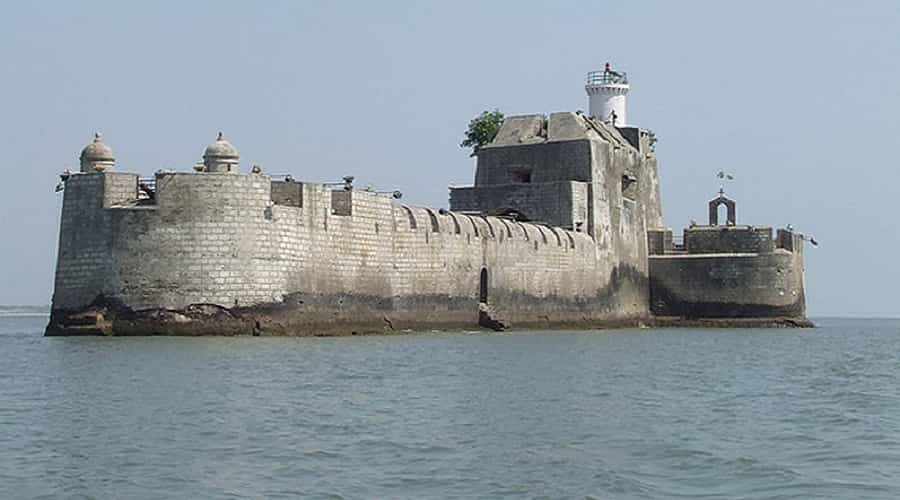
This ancient fort stands on the country’s western coast, in the union territory of Diu. The fort came into being in the year 1535 and further construction work took place around 1541, resulting in extension of the fort. This fort was erected by the Portuguese and its structure consists in several small chapels plus a double moat. A vast array of mighty cannons graces the ramparts.
- Built by: Portuguese
- Year: 16th century
- Location: Fort Road, near to PWD Office, Diu
- Visit Duration: 1 to 2 hours
- Entry Fee: No entry fee
- Timings: : 08:00 AM to 06:00 PM
- Best time to Visit: October to February
- How to Reach: Nearest airport- Diu Airport (8 km), nearest railway station- Varaval Railway station (90 km).
Also Read: Best Places to Visit in Diu
Watson Museum, Rajkot
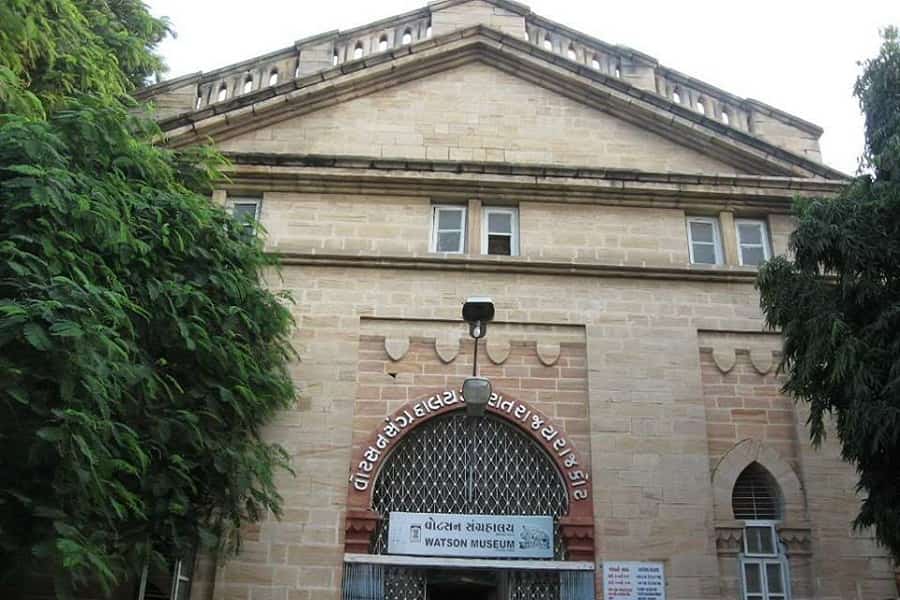
Watson museum in Gujarat’s Saurashtra region is one of the prominent museums of Gujarat. It is administered by the state government. The museum exhibits several attractive princely goods from the ancient province of Rajkot; a princely province created by the famed Jadeja clan. Artifacts, photographs, other invaluable goods are on display at the museum. There is a small library at the museum. The museum was named after John Watson, the famed British colonel belonging to Kathiawar agency.
- Built by: John Watson
- Year: 1888
- Location: Jubilee Garden, Rajkot
- Visit Duration: 30 Mins to 1 Hr
- Entry Fee:
- For Indian – ₹-10/-
- Foreign Tourists – ₹-100/-
- Timings: 09:00 AM to 06:00 PM
- Best time to Visit: September to February
- How to Reach: Nearest airport- Rajkot Airport (3 km), nearest railway station- Rajkot Junction Railway station (2 km).
Adalaj Vav (Step-well), Gandhinagar
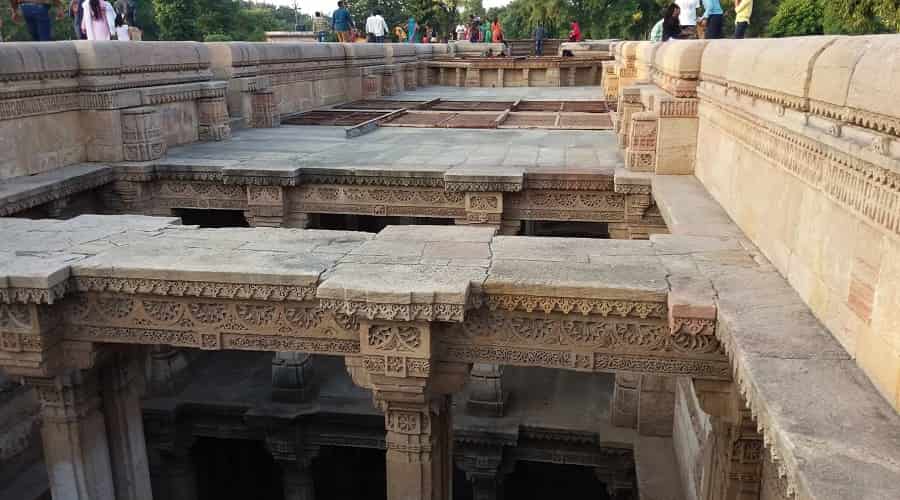
Adalaj Vav is one of the best Gujarati step-wells. It was built by Queen Rudabai in 1499. It is 19th kom north of Ahmedabad and any bus going towards Gandhinagar will take you there. There are three entrances to Adalaj Vav leading to the huge platform that has 16 huge pillars.
This is an octagonal well and is five storey deep. If you look at the stones, there are beautiful carvings on them, which tell about the great art works of those times. This place can be visited at 6:00 AM – 6:00 PM at all days of week.
- Built by: Queen Rudadevi
- Year: 1498-99
- Location: SH 41, Adalaj, 18 Kilometers North of Ahmedabad, 382421, Gujarat
- Visit Duration: Around 30 minutes
- Entry Fee:
- For Indian – Rs.20/-
- Foreign Tourists – Rs.250/-
- Timings: All days of the week 06:00 AM – 06:00 PM
- Best time to Visit: September to February
- How to Reach: Nearest airport- Sardar Vallabhai Patel airport (15 km), Nearest railway station- Kalupur Railway station, Ahmedabad (18 km).
Sarkhej Roza, Ahmedabad
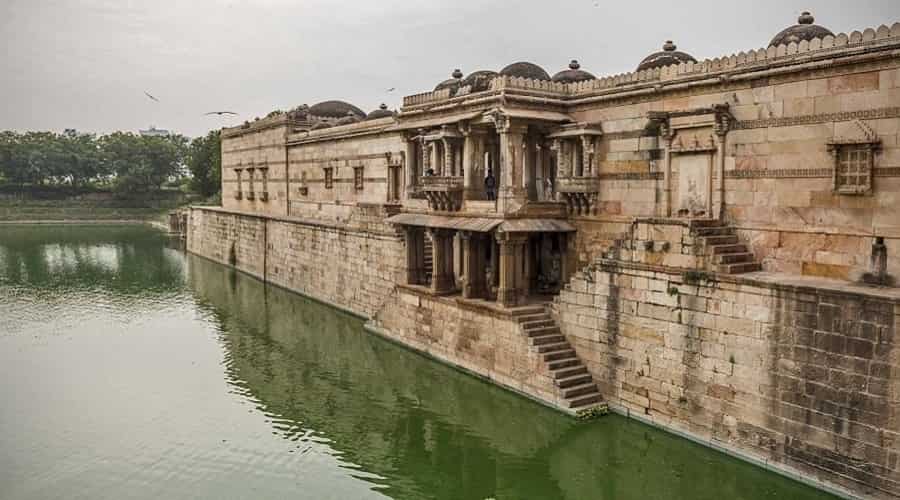
Sarkhek Roza is a tomb, mosque and a palace complex around 8 kms from the old center, in the Sarkhej area, Ahmedabad. The complex was dedicated to Ahmed Shah’s spiritual advisor Ahmed Khattu Ganj Bakhsh. It was constructed by of Sultan Mahmud Begada in the mid fifteenth century.
The mausoleums of Sultan Mahmud Begada and Khattu Ganj Bakhsh are both there at the entrance. The place has a lot of historical significance and therefore appeals to the people interested in history. It is a peaceful place and is good to spend some time with.
- Built by: Sultan Mahmud Begada
- Year: 1410-1443 A.D.
- Location: Makarba, Jivraj Park, Ahmedabad – 380051, Gujarat
- Visit Duration: Around 2-3 hours
- Entry Fee: No entry fees
- Timings: 09:00 am – 06:00 pm
- Best time to Visit: September to March
- How to Reach: Nearest airport- Sardar Vallabhai Patel airport (15 km), Nearest railway station- Kalupur Railway station, Ahmedabad (11 km).
Lothal, Saragwala
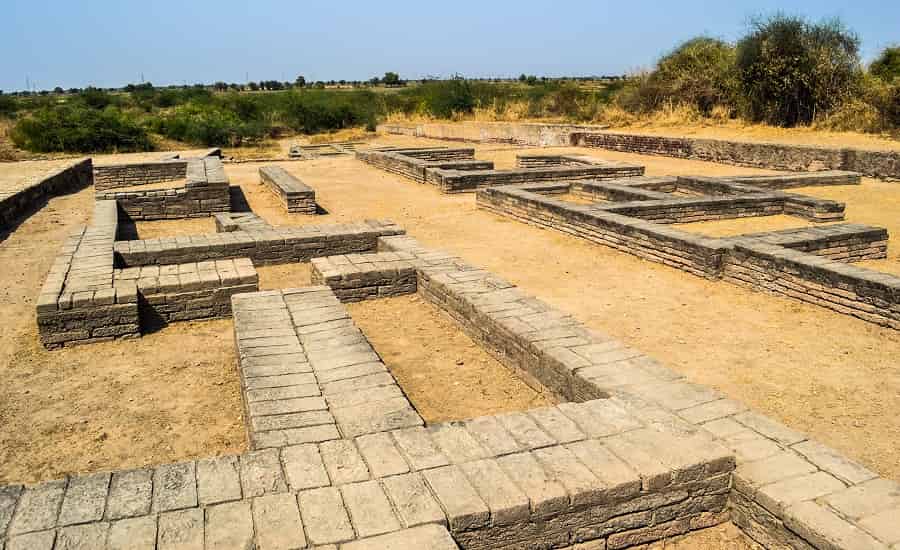
Lothal when discovered in 1954, marked an important event depicting the long tale of civilization in the Indian region. It was a part of Indus Valley civilization that flourished around 4000 years ago and therefore has an important role in the history. Therefore, people who are in the archaeological studies, are often fascinated by this place and visit here often. The site has a set of scattered structures and buildings that tell us that civilization has existed here before, thousands of years back. A number of things that were found here, proved that there was a trade route from this region to Egypt and similar other countries.
Lothal is a day long trip from Ahmedabad and is therefore an exciting journey. One can hire a taxi and go there. The site museum is also very cheap and you will not have to spend much here. The museum holds the important proofs that depict the story of the various turns and events in the historical context. Putting these pieces together, historians have been able to find out the growth of cultures and civilizations in the Indus valley region.
- Time Period: 2200 BCE
- Location: 87 kms from Ahmedabad , Gujarat
- Visit Duration: 2 to 3 hours
- Entry Fee: Rs.5/-
- Timings: 10:00 am – 05:00 pm
- Best time to Visit: Feb to August
- How to Reach: Nearest airport- Sardar Vallabhai Patel airport (91 km), Nearest railway station- Bhurkhi, Ahmedabad ( 6-7 km).
Sabarmati Ashram, Ahmedabad
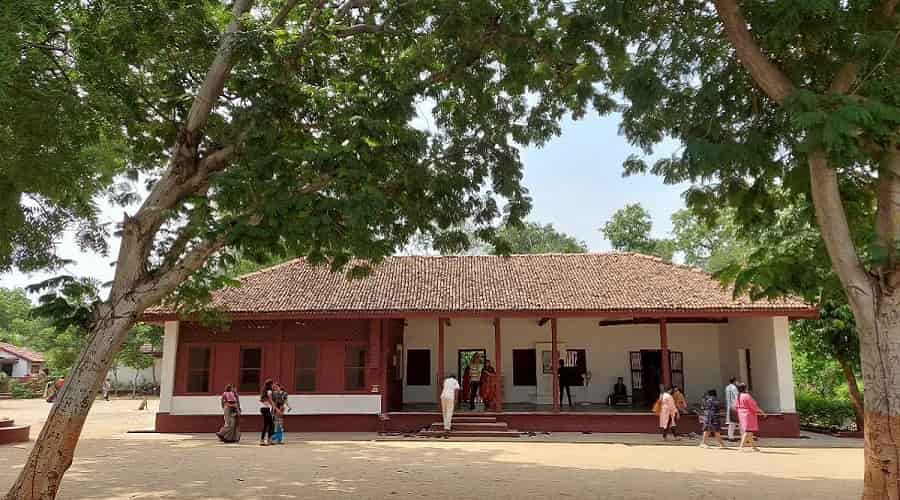
Sabarmati Ashram is one of the most important places to see in Gujarat. It is located around 5km north of the center, near the west bank of Sabarmati River and is a peaceful place with an aesthetic beauty. The place holds a special significance in the history of India. It was the place where Mahatma Gandhi lived most of the time. The Ashram was set between the jail and the cemetery and Mahatma Gandhi believed that these two were the main destinations for any Satyagraha or a non-violent protester.
The famous Dandi Yatra of 1930 began at this place only when Mahatma Gandhi decided to make salt and not return here until India had gained independence. The Ashram was disbanded in 1933 and later it became a place for Dalit welfare activities. After the death of Mahatma Gandhi the place was restored to preserve his memoirs.
If you are in Ahmedabad, you can easily reach there with a bus or auto rickshaw. The place is beautiful and serene. The architecture of the Ashram is majestic and the interiors are equally good. Inside it, there are memories of Mahatma Gandhi being preserved in form of pictures, texts and various other forms. There is a small museum too. The Ashram is well maintained and one falls in love with the place instantly. It will also help you in quickly going through the pages of Mahatma Gandhi’s life and the struggle of Indian independence. The Ashram remains open every day from 8:30am to 6:30pm.
- Founder: Mahatma Gandhi
- Year: 1963
- Location: Ashram Road, Old Wadaj, Ahmedabad, 380027, Gujarat
- Visit Duration: 1-2 hours
- Entry Fee: Free
- Timings: : 08:30 am to 06:30 pm
- Best time to Visit: October to March
- How to Reach: Nearest airport- Sardar Vallabhai Patel airport (8 km), Nearest railway station- Ahmedabad Junction (6 km).
Champaner and Pavagadh Archaeological Park
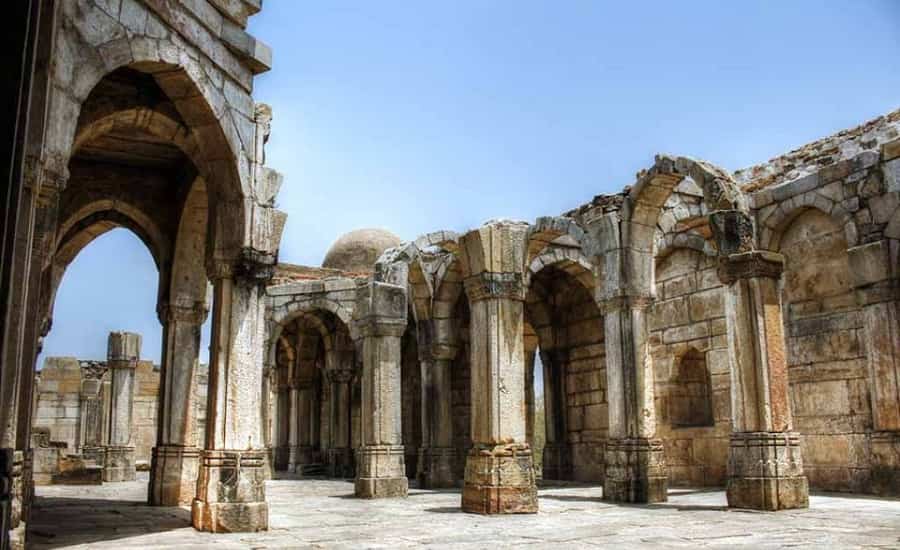
This is the UNESCO World Heritage site well known for its sacred hill – Pavagadh and the old capital of Gujarat with a wonderful mosque – Champaner. This site is 47 kms from the city of Vadodara. Pavagadh is a volcanic hill that has a long history of attacks and recovery. It was once the capital of Chauhan Rajput’s sultanate. Mughals also attacked here and therefore it has glimpses of Islamic culture as well. The Hindu and Jain religions are prevalent here and the culture is a beautiful amalgam of the mix of all.
Champaner on the other hand is very well known for its Citadel. It is a rectangular area of one square kilometers surrounded by large walls. The best thing about Champaner is its mosques which have beautiful Islamic and Hindu decorations and are a combination of the two cultures. The stone carvings, the structural designs and the prayer areas, all are wonderful and one cannot help to fall in love with this beautiful site.
- Built by: The Solanki kings & Khichi Chauhan Rajputs
- Year: 13th century
- Location: Jijabai Marg, Bhadra, Ahmedabad
- Timings: 8:00 AM – 6:00 PM
- Entry fee: Rs.40 for Indians & SAARC & BIMSTEC Nationals, Rs.600 for foreigners.
- Time required: 1-2 hours
- Best time to visit: November to February
- How to Reach
- By Road: One can conveniently get in Vadodara by road as it is well connected to National Highway-8 which connects all the major cities of India.
- By Airport: The closest Airport is located at Vadodara so, one can easily get in here via air.
- By Bus: Vadodara is easily accessible by bus as it has a good intercity bus service. Cars can be hired in Vadodara to drive to Champaner-Pavagadh
- By Train: Nearest railway station is located at Baroda/Vadodara.
Bhadra Fort and Teen Darwaza
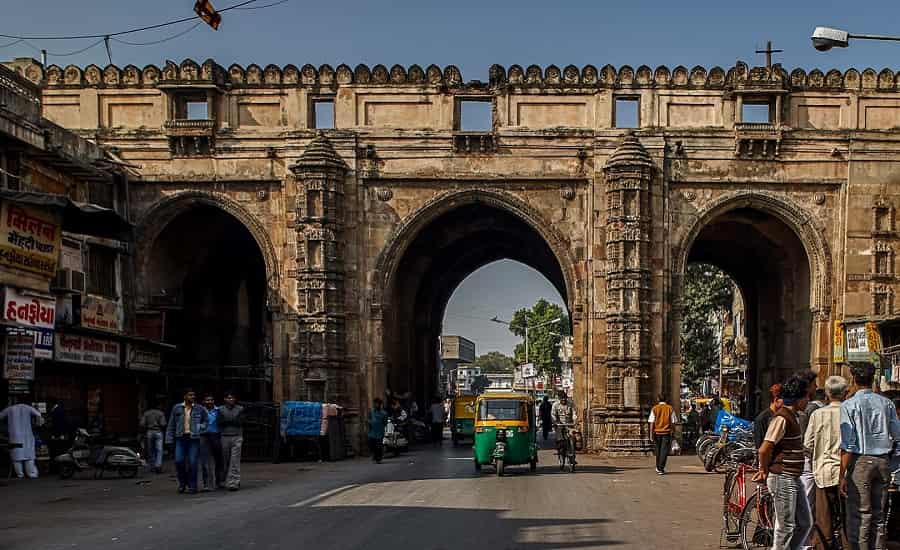
Bhadra Fort is almost as old as the city of Ahmedabad is. It was built around 1411 and is still in good condition. These days the fort mainly contains the government offices and a Kali temple. There is a Teen Darwaja, triple door gateway in front of the fort that makes it look even better in the appearance. Throughout the colonial rule, it has held a significant role as the polo games were generally played here. Today if you visit there you can enjoy hanging out and also the shopping as the market is pretty good.
- Built by: Ahmad Shah I
- Year: 15th century
- Location: Jijabai Marg, Bhadra, Ahmedabad
- Timings: This place can be visited at 9:00AM to 5:00PM
- Entry fee: No entry fee
- Time required: 30 minutes to 1 hour
- Best time to visit: Winter season
- How to Reach
- By Road: Ahmedabad is well connected via road to various cities and places in Gujarat.
- By Airport: Nearest airport is Sardar Vallabhbhai Patel International Airport which is about 14 km from the heart of the city.
- By Bus: Maninagar is well connected through the bus to various places of Ahmedabad.
- By Train: Nearest railway station is Maninagar for Bhadra Fort & Teen Darwaza.
Gandhi House (Gandhi Smriti)
- Location: Porbandar, Gujarat.
- Significance: Birth Place of Mahatma Gandhi.
- Height: 79 feet.
- Foundation Stone Laid By: Sardar Patel.
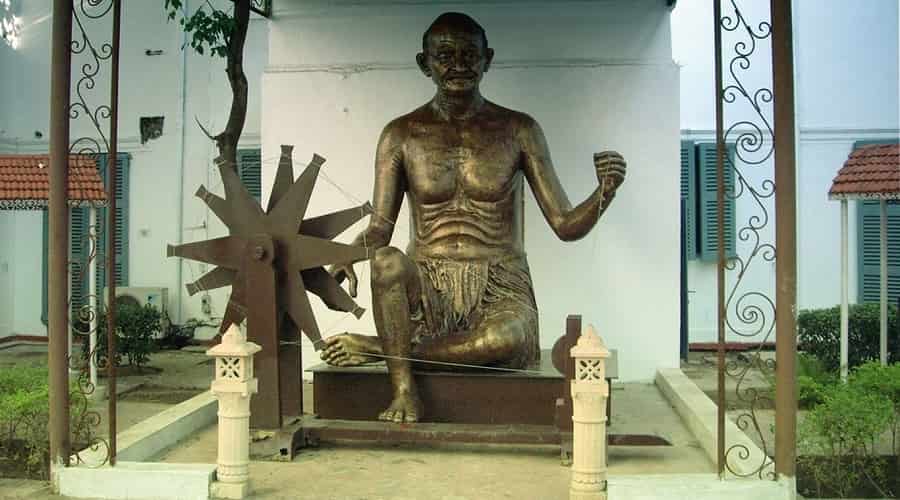
The state of Gujarat is not just a repository for the grandeur of India’s royal families but it is also the home of the father of the nation. Gandhi’s house at Porbandar serves as a tribute to this great hero of India’s freedom struggle.
Mahatma Gandhi was born in Porbandar on 2nd October, 1869 in a house which is situated at the rear side of the Haveli of Shrinathji. This house was bought from the member of Gandhi family who resided there during 1947. This house was then converted into a monument named Kirti Mandir. Indian government renovated the road leading to Gandhi’s house, by removing some of the structures from there.
The foundation stone of Gandhi’s house was laid in the year 1947 and the artwork was finished within a time period of two years after the foundation ceremony.
Significance
Kirti Mandir has been designed and built keeping in mind Gandhi’s life and principles. The height of this monument is 79 feet which symbolizes the life span of this great noble man. Besides, this monument is a house for religious integration of 6 religions of the world. This has been done to exhibit Gandhi’s respect towards all the religions of the world.
Gandhi was not in favor of posing himself as a god and thus there is no garland or flower placed around his photograph. Only the auspicious words like ‘The Truth’ and ‘Non-Violence’ are placed near his feet.
Inside the birthplace of Gandhi you will find the audio tapes of the Bhajans that are played inside this place. You can find some of the rare photographs in this hall.
There is also a library of book inside Kirti Mandir that is open for public use. This library has a huge collection of books that amounts to twenty thousand books presently.
How to Get There?
This is the most famous landmark of Gujarat. Hence, you can reach either by your personal modes of transport or can avail local transport as well.
Rao Pragmalji Palace (Prag Mahal)
- Location: Bhuj, Gujarat.
- Built In: Later Part Of 19th Century.
- Built By: Rao Pragmalji
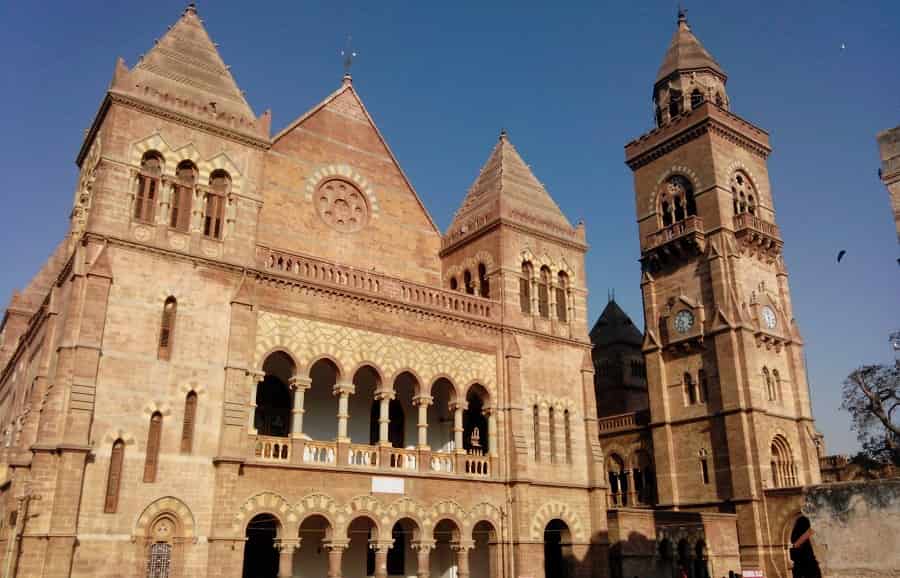
The experience of sauntering inside the premises of a royal house is incredible. The land of Gujarat is dotted with monuments that will surely amaze you. So when you land in Gujarat, you are blessed with the opportunity of seeing the lifestyles of kings and queens of India by checking their palaces and the articles displayed in it.
Rao Pragmalji palace is one such monument that will take you to the glorious days of Indian history. Besides this palace is situated the famous Aina Mahal which is one more attractive tourist spot of Gujarat.
Rao Pragmalji palace was designed by an apt British engineer, Col Wilkins. Although he is a British national many people mistook him as an Italian. The construction of this palace officially started in 1865 in order to replace small buildings. The palace includes a large Darbar Hall that measures 25m x 12m. This hall has a height of 12 m and consists of balconies, towers at its corners, Zenanas decorated with gilded carvings, Minton tiles and designs of marbles. You can get a spectacular aerial view of the surrounding places of the palace from its tall clock tower.
Rao Pragmalji palace was built for Rao Pragmalji II by the British architects in collaboration with Kutchi builders. You will get hints of Victorian-Edwardian style of architecture in the Darbar hall of the palace. The hall exhibits the art of taxidermy through the exhibition of stuffed wild animals. You will come across tiger skins and trophies which have been set against the walls. The Art Deco figurines are a matter of wonder in this hall. On one side of the palace there is a lodge that is designed in Italian style of masonry while on the other side the huge palace terrace is set.
The balconies of this palace have some fantastically carved wooden balconies. The palace is filled with lush green gardens that offer it a spectacular look.
You need to pay entry fees to see this palace.
Shaking Minarets
- Location: Ahmedabad, Gujarat.
- Part Of: Sidi Bashir Mosque.
- Unique Feature: On Shaking One Minaret, Other Also Shakes.
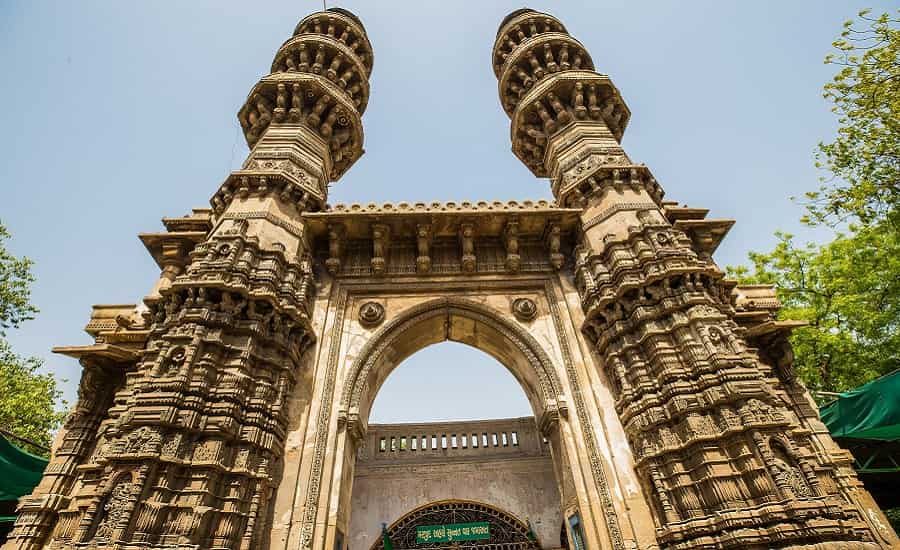
Discover one of the greatest unsolved mysteries of the world in Ahmedabad. The Shaking Minarets of Ahmedabad is a curious monument that stands on top of Sidi Bashir mosque. These minarets are a matter of study since British rule in India. Shaking Minarets of Ahmedabad made British rulers of India so curious, that they dismantled one of the minarets to find the solution to its shaking riddle.
Unique Feature of the Monument
Shaking Minarets of Ahmedabad derives its name from the unique feature it has. If one of the minarets is shaken then the other one vibrates as well by following the theory of resonance. The most surprising element of this monument is the passage that connects the two minarets. While the two minarets shake the passage connecting them is free from any vibration.
The Structure
The minarets are much famed and draws international tourist in massive numbers. Both the minarets are three-storied and are 21.34 m high. The minarets are embellished with elaborately carved stone balconies.
Other Minarets
There are a number of shaking minarets located within the region of Ahmedabad. Some of the minarets, like the minarets on Raj Bibi mosque have been destroyed by the British rulers of India to learn the mystery behind its shaking. But among all the minarets in Ahmedabad, the best one is the shaking minarets of Sidi Bashir mosque.
History
There are a million of myths regarding the shaking of the minarets at Sidi Bashir mosque. But the most popular among these beliefs is that they were made to shake in this way in order to avoid the perils of an earthquake. It is said that a European scholar of Sanskrit first observed that the minarets are shaking. Since then it got the name of ‘Shaking Minarets’.
There is also a mystery behind the builder of these minarets. Although the mosque is named after Sidi Bashir but actually the builder is Malik Sarang who was a noble in Sultan Shah Begada’s court. Malik Sarang was originally a Hindu Rajput who got influenced by the Sultan to convert to Islam.
Sahastralinga Talav
- Location: Patan, Gujarat.
- Built By: Jayasimha Siddharaja.
- Area: 17 Hectares.
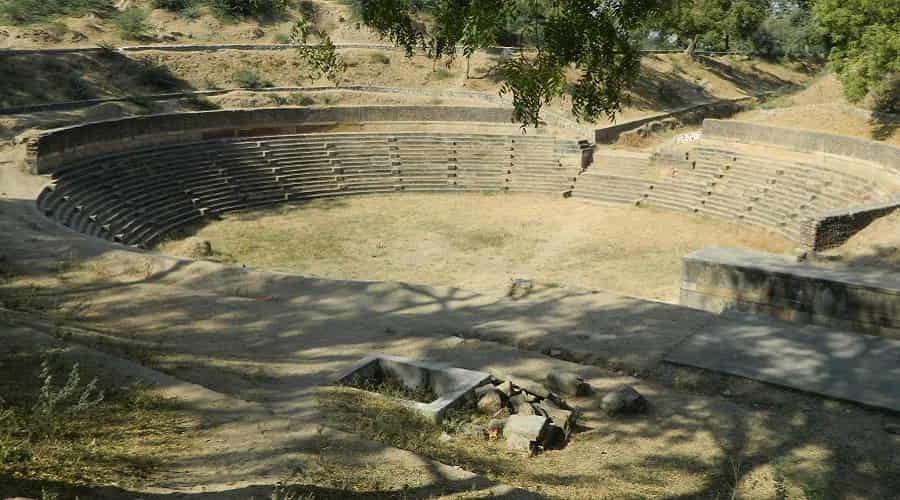
Gujarat is well known for the architectural wonders it posseses within its demographic region. The monuments, forts and plush palaces of Gujarat make every tourist ponder thoroughly about the structure. The monuments of Gujarat are internationally famed and Sahastralinga Talav is one among them.
Sahastralinga Talav is located on the banks of river Saraswati and occupies the north-western part of the city of Patan. This majestic lake was built by Siddharaja Jaisinh. Jaisinh was the Chalukyan ruler of Gujarat.
Sahastralinga Talav is a part of a much larger project that is indicated from the inscription found in Shiva temple located in Vyala Kua Street of Patan. Most of the construction of this lake lies beneath the sands of Saraswati River which once filled this lake. There is a myth about this present dryness of the lake. It says that one of the diggers, named Jasma Odan cursed this lake which resulted in its dryness.
How Was it Discovered?
This enormous lake which is a great work of water management by ancient Indians was excavated in the year 1936. The excavation exposed the entry channels, sitting chambers and a bridge that leads to the Talav or lake. The huge water tank was filled by a canal that connects to the Saraswati River. The collected water was then spread over 5 kms through a network of masonry embankments. Along the edge of the water tank thousands of shrines of Lord Shiva were constructed. Presently, only few of those shrines are remaining. The ruins of this monument will surely speak of the grandeur of its time.
The Structure of the Lake
The lake of Sahastralinga Talav has a pentagonal shape with several mounds that show its shape. The earthwork around the lake covers several kilometers and it is a km wide. The total area of the lake amounts to 17 hectares can hold 4206500 cubic meters of water in it.
At the center of the lake is a heap of earth named Bakasthana and above it there is a raised platform a rauza has been built.
The Myth
There is an interesting story behind the drying out of this huge lake. Folklore say that Siddharaja Jaisinh, the builder of this lake, proposed a lady named Jasma Odan, who was one of the diggers of this lake. She refused to marry Jaisinh and committed suicide in the form of Sati to save her honor. It is because of jasma Odan’s curse that this lake became dry and Siddharaja Jaisinh was left with no heir to the throne of his kingdom.
Sharad Baug Palace
- Location: Gujarat.
- Built In: 1867 AD.
- Highlights: Part of it has been converted into a museum.
- Orchard Retreat of: Maharao Madansinh.
- Timings: 9 am-12 pm and 3 pm-6 pm daily, except on Fridays.
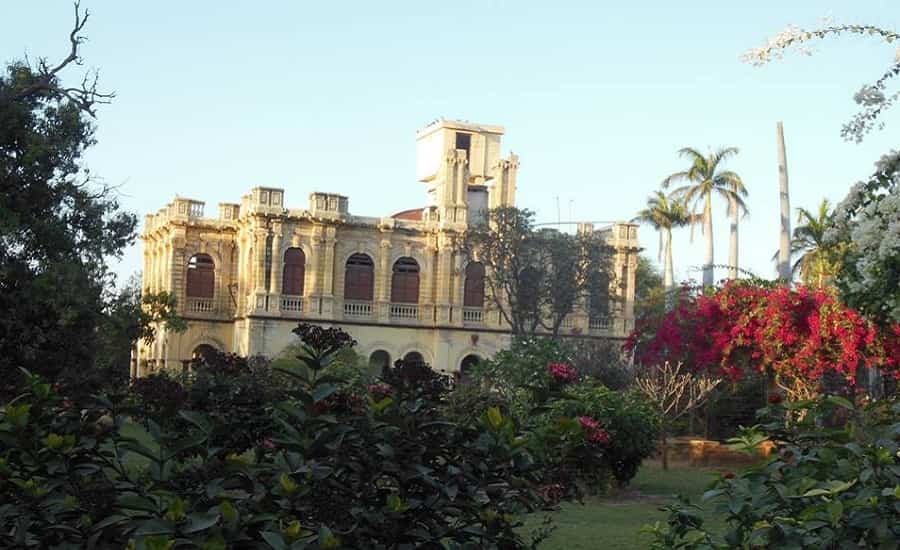
Welcome to the great land of Gujarat that holds the greatness of Indian history, culture and heritage. The pillars and walls of the monuments of Gujarat still retains the grandeur of the bygone days. Sharad Baug Palace is one among the many monuments that makes the land of Gujarat a favorite place for tourists.
Sharad Baug Palace is situated to the east of Hamirsar Lake. This palace was originally the orchard retreat, which belonged to Maharao Madan Sinh. This Italian style mansion houses beautiful gardens and consist of a very modest design. Sharad Baug Palace has a drawing room downstairs and all its bedrooms are constructed upstairs.
Interiors
The interiors of the palace consist of several rooms and some of which is now used as museums. These rooms have antique furniture, portraits, stuffed tigers, colonial trappings, silver caskets, elephant tusks, and trophies awarded to Madan Sinh for his performance in tennis and other sports.
There is a separate building which houses the dining room of the palace. This dining hall now displays the personal possessions of Madan Sinh. You will also find a coffin on display in this hall. This coffin was used to carry Madan Sinh’s body from U.K. for cremation.
The Gardens
The elaborate garden of this palace consists of plant nurseries. The grass courts of the garden were regularly used by Madan Sinh, where he invited tennis players. The green paths on the garden have a canopy of hibiscus and waving palms. You will come across several migratory birds which rest in this garden after their long and tiring flight over the desert of Rann of Kutch. The verdant palace garden is a favorite spot for tree lovers since guests are allowed to buy plants from the nurseries.
Digvir Niwas Palace
- Location: Vansda, Gujarat.
- Built In: The Early 20th Century.
- Nearby Attraction: Royal Gymkhana.
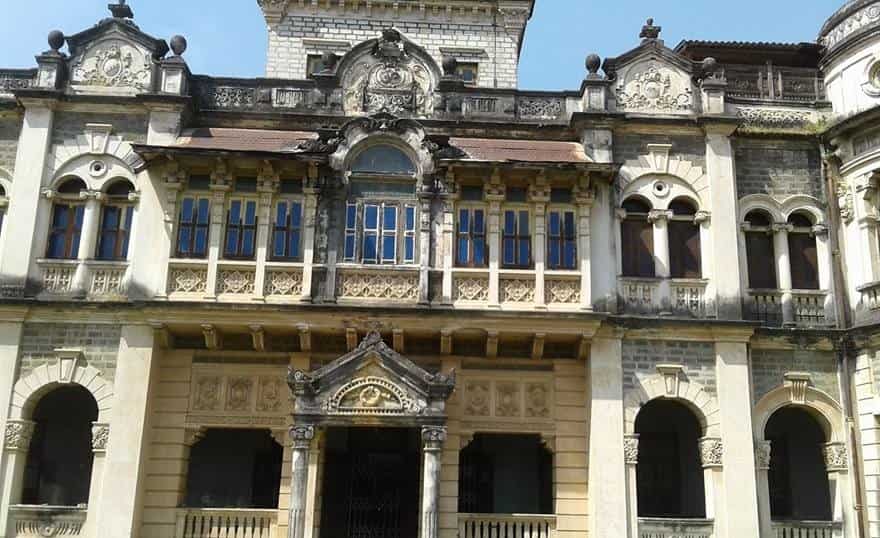
Do you remember those elaborate structures of palaces that are a typical with all fairytales of kings and queens? No need to remember them when you are at the Vansda city of Gujarat. You can feel the royal ambience within the different rooms of such a magnificent palace once you visit Digvir Niwas Palace.
Digvir Niwas Palace is one of the finest examples of imperial architecture in Gujarat, which was created in the 20th century. The imposing look of the palace lies in its boldly decorative plastered entrance and the octagonal ‘Chhatris’ set at either side of the entrance gate.
Palace Architecture
The masonry work of Digvir Niwas palace is based on ashlar stone. All the openings of this palace are decorated with white decorative plaster. The facade of the palace is richly designed with arches, curved balustrade, pediments, brackets, and verandahs of semicircular and octagonal shapes. The windows of this palace are fitted with stained glasses and have a sloping roof made of mansard. The architecture of the palace gives hint of inspiration from British and French chateaux of European aristocracy.
All these features together make this palace an appealing edifice.
Royal Gymkhana
The prime attraction of this palace lies in its gymkhana. This royal gymnasium resides within the palace compound. You will again witness hints of European style of architecture in this gymkhana. The gymkhana is designed in a manner similar to cricket pavilions of English nations. It has wooden trusses, sloping roofs, and Mangalore tiles for interior decoration. All together this cozy building constitutes a fine creation of royal luxury.
Few words about Vansda
The city of Vasanda in Gujarat has several such laces of tourist interest. The city boasts to hold within its territories some magnificent palaces, natural wonders like Saputara Hill Station. Naturally, you can organize a full day excursion of this city that will fill your mind with never-to-forget memories about Indian history.
How to Get There?
The nearest airport of Vasanda is Vadodara which is 297 km away. The Mumbai airport is located 248 kms from Vasanda. You can also reach this city by road from Ahmedabad, Surat and Valsad. Sidhapur railway station is located just 18 km away. The nearest road from the railway station is Unai Vansada Road.
Ranjit Vilas Palace
- Location: Wankaner, Gujarat.
- Built By: Amarsinji.
- Named After: His Close Friend, Ranjitsinhji.
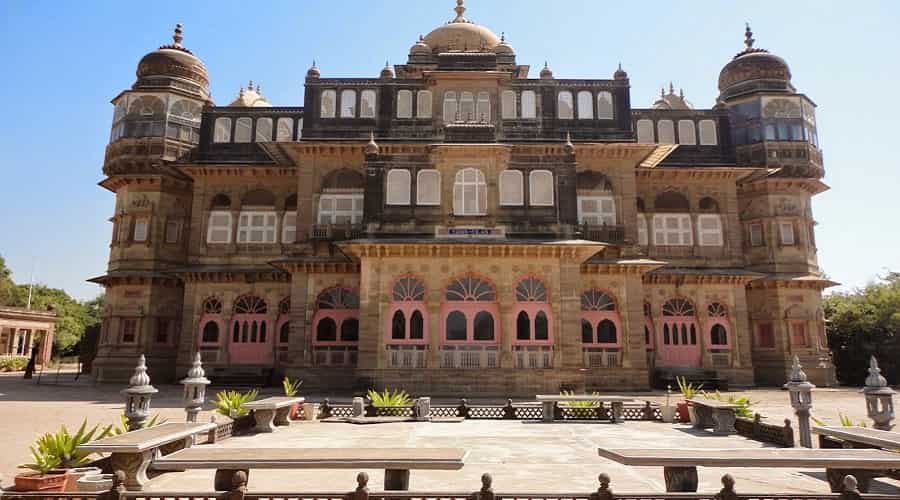
Ranjit Vilas palace is an example of innovative architecture which makes it one of its kinds in entire Gujarat. The location of this palace is the foremost factor that adds to its appealing design. The palace is situated on a hill top and it took almost 7 years to complete it.
The palace receives its singular importance from its designer Amarsinji who is also the founder of Ranjit Vilas palace. He designed this palace and named it after his beloved friend Ranjitsinhji of Jamnagar.
The ground are of Ranjit Vilas palace constitute a total of 225 acres. Within the premises of the palace you can see the state guest house and Chandra Bhavan.
The grand architecture of this palace makes it an eclectic one building. Once you observe the fine details of this bejewelled palace you will realize the designer’s bold attempt to synthesize different architectural fashions. The front and back facades of this palace are designed in accordance to the location of this palace.
The front part displays a series of terraces that culminates into a pair of pavilions designed by gothic arches. The rear side of the palace constitutes an impressive landmark. The rear portion has a sever storey clock tower that is capped by a Mogul dome. The tower is flanked by two five storied high citadels on its either side.
The palace interiors have Victorian windows, Italianate pillars, classical parapets and gothic arches. The central wing of the palace is topped by an enormous Dutch roof. The unique feature of the palace is its double staircase. Among these two staircases one was exclusively for royal ladies who can move up and down the palace without being seen by men.
Articles on Display
The palace has some exotic articles on display that is sure to enthrall you. You will come across memorable collections of daggers, shield, swords, 95 species of stuffed animals, chests of silver, silver-plated howdahs, paintings and portraits. The palace preserves some excellent antique chandeliers and furniture.
Collection of Vintage Cars
You should not miss out the vintage car collection on the palace ground, which includes horse-drawn carriages, Ro 1921 Rolls Royce Silver Ghost and American vintage cars.
The nearest airport to Wankaner is Rajkot which is 53 km away. The city of Ahmedabad is located 22 km from Wankaner. You will get local transports like non-metered auto rickshaws to reach this place.
- You May Also Like to Read: Popular Hindu Temples in Gujarat
FAQs (Frequently Asked Questions)
1- What are the must-visit historical places in Gujarat?
Gujarat is home to several must-visit historical places, including Lothal, Laxmi Vilas Palace, Dwarkadhish Temple, Rani ki Vav, and Champaner-Pavagadh Archaeological Park.
2- Which historical place in Gujarat is known for its stepwell?
Rani ki Vav, located in Patan, is a famous stepwell in Gujarat renowned for its intricate carvings and architectural beauty.
3- What is the significance of the Sun Temple in Modhera?
The Sun Temple in Modhera is dedicated to the solar deity, Surya, and represents exquisite architecture and cultural heritage.
4- What is the best time to visit the Rann of Kutch?
The best time to visit the Rann of Kutch is during the winter season, from November to February, when the weather is pleasant and the Rann Festival takes place.
5- What makes Ahmedabad a unique destination in Gujarat?
Ahmedabad stands out as a unique destination due to its blend of modernity and rich historical heritage, offering visitors a diverse range of attractions and experiences.
